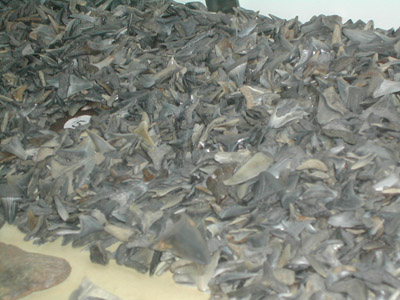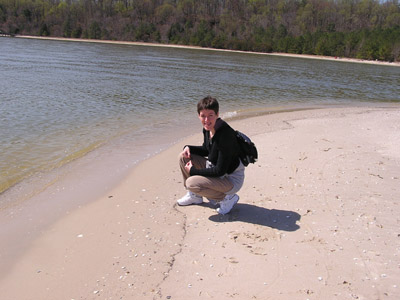
Mid-April, 2005. My sister and brother-in-law invited me to go with them to Calvert Cliffs, to take photos and look for fossils. It sounded interesting, so off we went, with me stuffed comfortably in the jump seat of Andrew's truck. (one of those trucks with the back half doors, a lot more comfortable than I thought they'd be!)
Warning! Lots of photos ahead!
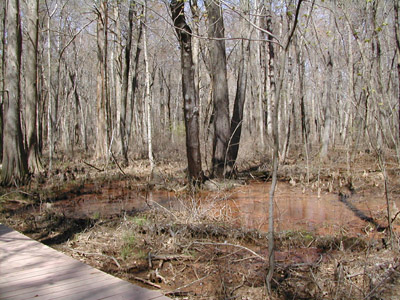 Our first stop was at Battle Creek Cypress Swamp. They had a very nice nature museum (including a live beehive inside the museum and a blind owl in a huge cage outside) and a long wooden boardwalk that wound throughout the grove of trees.
It being April, the trees had not yet sprouted leaves.
Our first stop was at Battle Creek Cypress Swamp. They had a very nice nature museum (including a live beehive inside the museum and a blind owl in a huge cage outside) and a long wooden boardwalk that wound throughout the grove of trees.
It being April, the trees had not yet sprouted leaves.
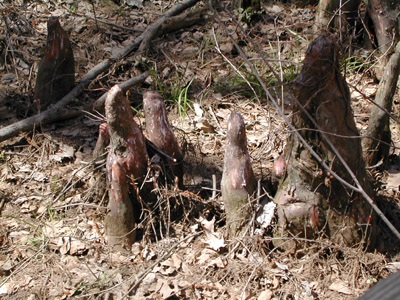 I didn't know much about Cypress trees, and soon learned that their distinguishing feature is their knees. It has something to do with being in a swamp and needing extra balance. All I know for certain is that they look odd!
I didn't know much about Cypress trees, and soon learned that their distinguishing feature is their knees. It has something to do with being in a swamp and needing extra balance. All I know for certain is that they look odd!
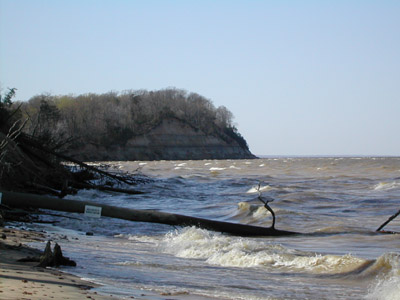 After that, we headed to Calvert Cliffs. After a two mile hike (and a detour) through the woods and park, we arrived at the beach, only to discover that it was
very cold, incredibly windy, and the beach left a lot to be desired.
After that, we headed to Calvert Cliffs. After a two mile hike (and a detour) through the woods and park, we arrived at the beach, only to discover that it was
very cold, incredibly windy, and the beach left a lot to be desired.
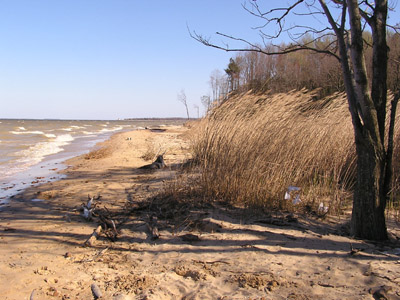 The fragile state of the cliffs prompted the Park Authority to post "No Trespassing" signs
everywhere. The wind made a whistling sound through the reeds. It felt like a very cold, lonely, abandoned, run down place. (possibly because I was cold and tired!)
The fragile state of the cliffs prompted the Park Authority to post "No Trespassing" signs
everywhere. The wind made a whistling sound through the reeds. It felt like a very cold, lonely, abandoned, run down place. (possibly because I was cold and tired!)
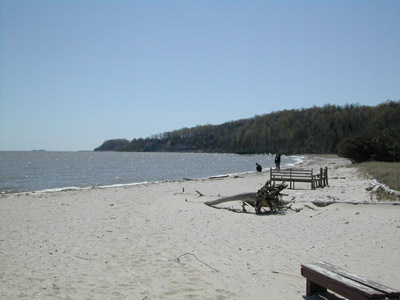 Our trip took a turn for the better when we discovered Flag Ponds Nature Park.
Again, we were there too early in the season to appreciate the ponds, flowers, and wildlife. However, it was such a nice place!
A large portion of the beach was roped off, and a sign indicated it was for fossil hunters only. It was still very cold, and very windy. The sand at this beach was much cleaner, and had been warmed by the sun.
Our trip took a turn for the better when we discovered Flag Ponds Nature Park.
Again, we were there too early in the season to appreciate the ponds, flowers, and wildlife. However, it was such a nice place!
A large portion of the beach was roped off, and a sign indicated it was for fossil hunters only. It was still very cold, and very windy. The sand at this beach was much cleaner, and had been warmed by the sun.
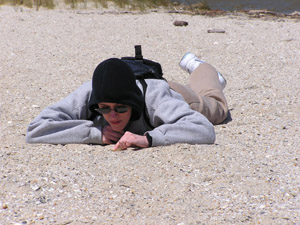 And so we began our search. It took a good twenty minutes or so before Erin found the first shark tooth. Oh! So THAT's what they look like! After that, it became easier. I was soon stretched out on my stomach, where I was less
of a target to the wind, and the sand felt so nice and warm. (I now fully understand the meaning of the term "beachcombing".)
And so we began our search. It took a good twenty minutes or so before Erin found the first shark tooth. Oh! So THAT's what they look like! After that, it became easier. I was soon stretched out on my stomach, where I was less
of a target to the wind, and the sand felt so nice and warm. (I now fully understand the meaning of the term "beachcombing".)
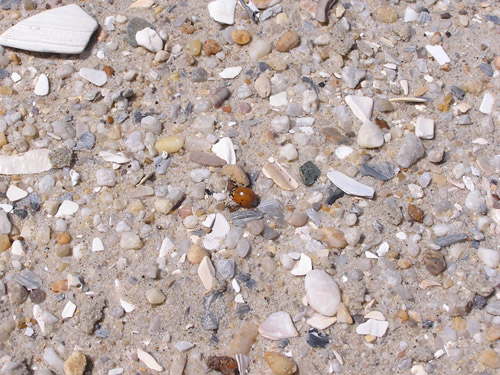 It was the most interesting beach I had ever seen. The Outer Banks in NC is very rough, full of broken shells and little critters. The sand at Orange Beach, Alabama, was powder soft and
had a tint of orange, and the shells were whole (and also orangy). Here, it was cluttered with stuff. Big shells, little shells, stones, crab bits, lady bugs, and fossils. I would not want to walk barefoot on this beach!
It was the most interesting beach I had ever seen. The Outer Banks in NC is very rough, full of broken shells and little critters. The sand at Orange Beach, Alabama, was powder soft and
had a tint of orange, and the shells were whole (and also orangy). Here, it was cluttered with stuff. Big shells, little shells, stones, crab bits, lady bugs, and fossils. I would not want to walk barefoot on this beach!
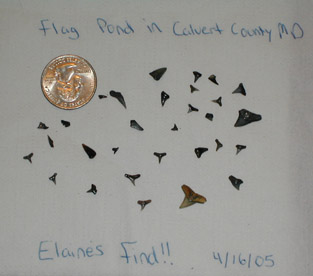 By the end of the day, we had found quite a few tiny teeth. It seems that sharks constantly lose and regenerate their teeth. There didn't need to be a large shark population in the area for there to be so many teeth! Being a miniaturist, I suspect that I was subconciously looking for the tinier teeth. (and finding them, too!)
By the end of the day, we had found quite a few tiny teeth. It seems that sharks constantly lose and regenerate their teeth. There didn't need to be a large shark population in the area for there to be so many teeth! Being a miniaturist, I suspect that I was subconciously looking for the tinier teeth. (and finding them, too!)
 Flag Ponds also has a very nice Visitor's Center. On display were thousands of shark teeth that had been pulled from the beach. They also had photos detailing the changes to the coastline, a handy display
showing and describing the things you might find on the beach (including little blue fuzzy balls that had escaped from the cleaning systems of the nearby power plant) and just a big, nice, open area to sit, relax, thaw out . . .
Flag Ponds also has a very nice Visitor's Center. On display were thousands of shark teeth that had been pulled from the beach. They also had photos detailing the changes to the coastline, a handy display
showing and describing the things you might find on the beach (including little blue fuzzy balls that had escaped from the cleaning systems of the nearby power plant) and just a big, nice, open area to sit, relax, thaw out . . .
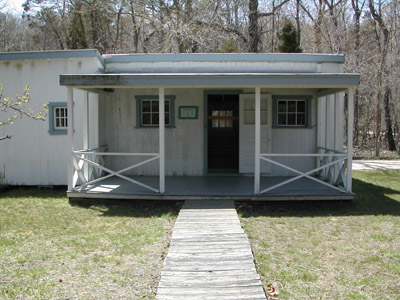 We returned to the place the next morning, unable to resist a second visit. We had a very nice breakfast of bagels and cream cheese on the front porch of a fishermen's shanty that was on display.
Such a difference from the day before! The temperature had risen, and the wind had dropped. We spent a few more hours digging through the sand and enjoying the weather.
We returned to the place the next morning, unable to resist a second visit. We had a very nice breakfast of bagels and cream cheese on the front porch of a fishermen's shanty that was on display.
Such a difference from the day before! The temperature had risen, and the wind had dropped. We spent a few more hours digging through the sand and enjoying the weather.

